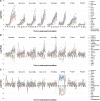A systems approach to prion disease
- PMID: 19308092
- PMCID: PMC2671916
- DOI: 10.1038/msb.2009.10
A systems approach to prion disease
Abstract
Prions cause transmissible neurodegenerative diseases and replicate by conformational conversion of normal benign forms of prion protein (PrP(C)) to disease-causing PrP(Sc) isoforms. A systems approach to disease postulates that disease arises from perturbation of biological networks in the relevant organ. We tracked global gene expression in the brains of eight distinct mouse strain-prion strain combinations throughout the progression of the disease to capture the effects of prion strain, host genetics, and PrP concentration on disease incubation time. Subtractive analyses exploiting various aspects of prion biology and infection identified a core of 333 differentially expressed genes (DEGs) that appeared central to prion disease. DEGs were mapped into functional pathways and networks reflecting defined neuropathological events and PrP(Sc) replication and accumulation, enabling the identification of novel modules and modules that may be involved in genetic effects on incubation time and in prion strain specificity. Our systems analysis provides a comprehensive basis for developing models for prion replication and disease, and suggests some possible therapeutic approaches.
Conflict of interest statement
The authors declare that they have no conflict of interest.
Figures







Comment in
-
A landmark systems analysis of prion disease of the brain.Mol Syst Biol. 2009;5:254. doi: 10.1038/msb.2009.12. Epub 2009 Mar 24. Mol Syst Biol. 2009. PMID: 19308093 Free PMC article. No abstract available.
Similar articles
-
Complement 3+-astrocytes are highly abundant in prion diseases, but their abolishment led to an accelerated disease course and early dysregulation of microglia.Acta Neuropathol Commun. 2019 May 22;7(1):83. doi: 10.1186/s40478-019-0735-1. Acta Neuropathol Commun. 2019. PMID: 31118110 Free PMC article.
-
Flow Cytometric Detection of PrPSc in Neurons and Glial Cells from Prion-Infected Mouse Brains.J Virol. 2017 Dec 14;92(1):e01457-17. doi: 10.1128/JVI.01457-17. Print 2018 Jan 1. J Virol. 2017. PMID: 29046463 Free PMC article.
-
An astrocyte cell line that differentially propagates murine prions.J Biol Chem. 2020 Aug 14;295(33):11572-11583. doi: 10.1074/jbc.RA120.012596. Epub 2020 Jun 19. J Biol Chem. 2020. PMID: 32561641 Free PMC article.
-
Prion encephalopathies of animals and humans.Dev Biol Stand. 1993;80:31-44. Dev Biol Stand. 1993. PMID: 8270114 Review.
-
Genetics of prion diseases and prion diversity in mice.Philos Trans R Soc Lond B Biol Sci. 1994 Mar 29;343(1306):363-9. doi: 10.1098/rstb.1994.0030. Philos Trans R Soc Lond B Biol Sci. 1994. PMID: 7913753 Review.
Cited by
-
The degree of astrocyte activation is predictive of the incubation time to prion disease.Acta Neuropathol Commun. 2021 May 12;9(1):87. doi: 10.1186/s40478-021-01192-9. Acta Neuropathol Commun. 2021. PMID: 33980286 Free PMC article.
-
Presence of an acute phase response in sheep with clinical classical scrapie.BMC Vet Res. 2012 Jul 17;8:113. doi: 10.1186/1746-6148-8-113. BMC Vet Res. 2012. PMID: 22805457 Free PMC article.
-
The cell type resolved mouse transcriptome in neuron-enriched brain tissues from the hippocampus and cerebellum during prion disease.Sci Rep. 2019 Jan 31;9(1):1099. doi: 10.1038/s41598-018-37715-z. Sci Rep. 2019. PMID: 30705335 Free PMC article.
-
Transcriptional changes in the brains of cattle orally infected with the bovine spongiform encephalopathy agent precede detection of infectivity.J Virol. 2009 Sep;83(18):9464-73. doi: 10.1128/JVI.00352-09. Epub 2009 Jul 8. J Virol. 2009. PMID: 19587050 Free PMC article.
-
Principal network analysis: identification of subnetworks representing major dynamics using gene expression data.Bioinformatics. 2011 Feb 1;27(3):391-8. doi: 10.1093/bioinformatics/btq670. Epub 2010 Dec 30. Bioinformatics. 2011. PMID: 21193522 Free PMC article.
References
-
- Ben-Zaken O, Tzaban S, Tal Y, Horonchik L, Esko JD, Vlodavsky I, Taraboulos A (2003) Cellular heparan sulfate participates in the metabolism of prions. J Biol Chem 278: 40041–40049 - PubMed
-
- Berriz GF, King OD, Bryant B, Sander C, Roth FP (2003) Characterizing gene sets with FuncAssociate. Bioinformatics 19: 2502–2504 - PubMed
Publication types
MeSH terms
Substances
Grants and funding
LinkOut - more resources
Full Text Sources
Other Literature Sources
Molecular Biology Databases
Research Materials

